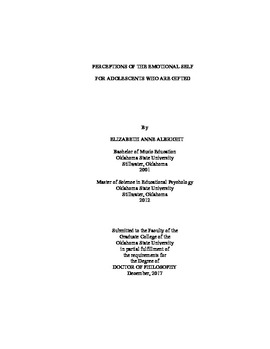| dc.description.abstract | Abstract: Adolescence is a time of emotional turmoil as the transition to adulthood is experienced. For adolescent students who are gifted or talented, the research demonstrates unique issues such as sensitivity, perfectionism, and asynchronous development. Self-report, trait-based instruments have provided longitudinal and comparative data about adolescents. However, little has been done from the subjective viewpoint of the adolescent who is gifted. Therefore, the purpose of this study is to discover the ways adolescents who are identified as gifted describe their emotional selves. Q methodology was used to conduct the study. The theoretical framework of emotionality was constructed in a four (Emotional intelligence, Mayer, Caruso, & Salovey, 2000) by five (Emotional development, Dabrowski, 1966) Fisherian design. Emotionality was used to sample the concourse of possible emotional indicators. The 41-item Q set was sorted by the 28 adolescents identified as gifted by the public school district personnel. Four factor arrays were interpreted using PQMethod output, field notes taken during the sorting interview, demographic information about defining sorters, and post sort interviews. The four factor arrays were characterized by ability to detect and understand their emotional states and the emotional states of others. Further definition was observed by the coping mechanisms used to resolve conflicts within their peer group. These four groups are the Humanitarians, adolescents who value social justice; Politicians, adolescents who want to learn about the feelings of others, but are hesitate to reveal themselves; Regulators, adolescents who maintain a superficial life without conflict; and Stabilizers, adolescents who exhibit a constant tension of feelings and visibility of emotion. Results from this study inform practitioners working with students who are gifted. This study adds to the body of literature as it introduces a unique theoretical framework of subjective emotionality. | |
